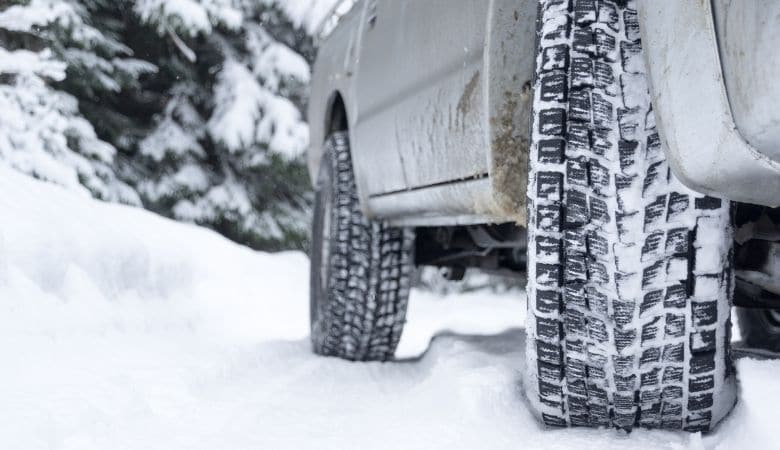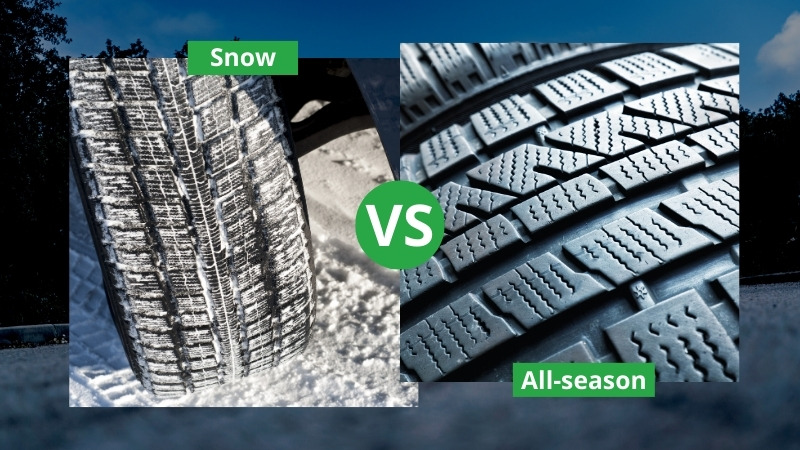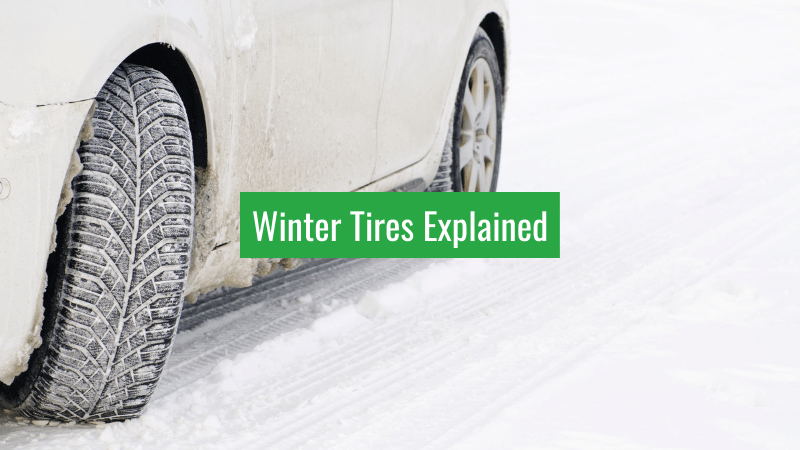As a driver, you might wonder why winter tires are essential for your vehicle and when you should use them.
Winter tires, also known as snow tires, are designed to provide optimal performance in cold, icy, and snowy conditions. This is because they offer improved traction, braking, and handling during the chilly months compared to all-season tires.
It’s important to understand that winter tires are not only meant for snowy roads. They are made with a softer rubber compound, which contains a higher silica content, enabling them to remain flexible and perform better in temperatures below 45 degrees Fahrenheit (7 Celsius) and in wet conditions.
This enhanced flexibility allows them to maintain better contact with the road, ensuring safer and more reliable driving for you during the winter months.
Now that you have a basic understanding of what winter tires are and why they are essential, you might be curious about when to switch to them and how they can improve your winter driving experience.
In the following paragraphs, we will further explain the benefits of using winter tires and provide you with practical tips for making the most of them during the cold season.
The 3 Winter Tire Types Explained
As winter approaches, it’s essential to equip your vehicle with the right type of tires to ensure safety and optimum performance in cold and slippery conditions.
Here is a brief introduction to the three common types of winter tires: Studded, Studless, and Studdable.
1. Studded Winter Tires
Studded winter tires are equipped with small metal studs embedded in the tread. These studs provide extra traction, helping your vehicle securely grip the ice-covered roads.
However, studded tires can cause damage to pavement, so some regions have restrictions on their use, so be sure to check local regulations before choosing this type. Additionally, studded tires may be noisy on dry roads or pavements.
2. Studless Winter Tires
Also known as non-studded winter tires, studless tires don’t have any studs in the tread. Instead, they rely on a unique tread pattern and softer rubber compound that remains flexible in low temperatures to provide traction on snow and ice.
These tires often feature a three-peak mountain snowflake symbol on the sidewall, indicating their winter capabilities. Studless winter tires are less likely to damage the pavement and are generally quieter than studded tires.
3. Studdable Winter Tires
Studdable winter tires offer the best of both worlds. They come with a tread design that allows for the optional addition of metal studs. This flexibility lets you decide whether to use the studs based on the specific winter conditions in your area or personal preference.
Keep in mind that adding studs to studdable tires is an additional cost and may be subject to local restrictions.
When selecting the right type of winter tire for your vehicle, consider the average winter conditions of your region and your driving needs.
Each tire type has its pros and cons, so choosing the most suitable tire for your specific requirements will help ensure a safer and more enjoyable driving experience during the cold months.
Benefits of Winter Tires

Improved Grip on Snow and Ice
Winter tires have a significant advantage over all-season tires when it comes to grip on snow and ice. One of the reasons for this is the use of a softer rubber compound in the construction of winter tires.
This compound remains flexible in cold weather, allowing the tire to conform to the road better and increase traction in temperatures below 45 degrees Fahrenheit (7 Celsius).
The tread of winter tires also plays a crucial role in their performance in wintery conditions. Winter tire tread is designed with special patterns called sipes which pick up and hold snow against the tire, improving grip. This is because snow sticks to snow better than any other material, so having snow-packed sipes allows for better traction.
Enhanced Safety and Handling
Using winter tires greatly improves the overall safety and handling of your vehicle during the winter months. One key aspect of this enhanced safety is the significant reduction in braking distance when compared to all-season tires.
Winter tires can help drivers reach a complete stop 30% faster, taking only 34 feet when traveling at 12 miles per hour as opposed to 57 feet with all-season tires.
Another factor that contributes to the improved safety of winter tires is their ability to provide better turning and handling in cold weather conditions, decreasing the risk of accidents and loss of vehicle control.
The unique design of winter tires, including their softer rubber compound and sipes, helps maintain standard vehicle performance in terms of braking and turning, which allows for greater control and responsiveness while driving in winter conditions. This results in a safer driving experience for you and your family.
In addition to improved grip on snowy and icy roads, winter tires also have specialized grooves that channel water away from the tire’s contact patch, reducing the risk of hydroplaning in wet conditions. With better grip and overall performance, winter tires can help keep you safe on the road during winter months.
Choosing the Right Winter Tires
Features to Look for
When selecting winter tires for your vehicle, there are several key features to consider. First and foremost, the rubber compound of the tire should be designed to remain soft, supple, and compliant even in sub-freezing temperatures, which helps provide better traction on ice and snow.
Tread design is also crucial, as it helps wick away water and slush to improve grip. Look for tires with biting edges, or small blocks in their tread patterns, that help to grip and maintain traction in winter conditions.
Another essential factor to consider is durability. Opt for tires that offer increased tread life and can maintain their effectiveness even as they wear down. A good rule of thumb is to replace winter tires when their tread depth reaches 5/32-inch.
Popular Brands and Options
Several popular brands offer quality winter tires. Bridgestone and Pirelli are known for manufacturing tires that excel in winter conditions. Always consult your vehicle’s owner’s manual or the placard on the driver’s side door jamb for the recommended tire size and consult your local tire retailer for specific brand and model options.
Depending on where you live and the specific winter conditions you’ll encounter, such as heavy snow or icy roads, you may have different needs. In Canada, for instance, winter tires are considered essential for added safety and driver confidence. Use your judgment and local recommendations to help make your decision.
Keep in mind that while all-season tires may offer some traction and performance benefits in winter conditions, they do not provide the same level of safety and confidence that dedicated winter tires can, particularly when it comes to braking and cornering on snow and ice.
Preparing for Winter Driving

Installing a Dedicated Set of Wheels
When winter comes, you’ll want to have the best traction and control possible. A dedicated set of wheels with winter/snow tires can significantly improve your vehicle’s performance in icy and snowy conditions.
Rather than relying solely on all-wheel-drive or anti-lock brakes, having a separate set of wheels for winter ensures that you have the ideal tire composition and tread pattern specifically designed for cold, wintry weather.
In many European countries, it is mandatory to install winter tires during the cold season. This is because snow tires provide improved steering and braking capabilities on snowy or icy roads. When choosing a set of winter wheels, you have two options: steel wheels or alloy wheels.
Steel wheels are a more affordable option and offer greater resistance to winter weather damage. However, they can be heavier and less visually appealing than alloy wheels. On the other hand, alloy wheels are lighter and have better heat dissipation, which can help enhance brake performance in extreme conditions.
Ultimately, the choice between steel and alloy wheels is yours, but either option will provide significant benefits when paired with winter/snow tires.
Switching Between Summer and Winter Tires

When preparing your vehicle for the winter season, it’s important to switch out your summer tires for winter ones. It’s essential to keep in mind that all-wheel drive and anti-lock brake systems can only help you so much; having the right tires is crucial to maintaining traction and control on slippery roads.
Winter tires are made from a softer rubber compound that remains flexible at lower temperatures, providing better grip on icy and snow-covered road surfaces. Additionally, they have specialized tread patterns designed to channel away snow and slush, promoting better contact with the road.
To ensure optimal performance and safety, it’s essential to switch back to summer tires once winter is over. Using winter tires during warmer months can lead to faster wear due to the softer rubber compound and decreased fuel efficiency.
In summary, driving in winter weather requires a dedicated set of wheels and switching between summer and winter tires. Doing so will ensure that you have the best possible traction and control, no matter the road conditions.
Remember, all-wheel-drive and anti-lock brakes can only do so much; having the right tires will make all the difference in your winter driving experience.
Winter Tires and Accident Prevention
As a driver, it’s important to understand how winter tires can play a significant role in accident prevention during harsh winter conditions. In this section, we’ll discuss how winter tires can help reduce braking distance and decrease the risk of crashes.
Reduced Braking Distance
Winter tires are designed with specific rubber compounds that maintain their flexibility and grip at lower temperatures compared to all-season tires, which tend to harden at temperatures below 7ºC. This improved flexibility in cold temperatures allows for better snow traction and more effective braking.
The treads on winter tires are also designed for snow-covered roads. This results in an enhanced grip when braking, which can significantly reduce your braking distance. In fact, studies have shown that winter tires can provide improved traction, braking, and handling in all cold-weather driving conditions compared to all-season tires.
Decreasing the Risk of Crashes
When you drive with winter tires, you are less likely to experience skidding or loss of control during acceleration and braking in snowy or icy conditions. The improved snow traction offered by winter tires allows your vehicle to better respond to changes in weather conditions.
For Canadian drivers in particular, using winter tires can be a lifesaver. According to the Tire and Rubber Association of Canada, winter tire usage has more than doubled since 1998, with 76% of drivers using them in 2021. This increased usage has likely contributed to a decrease in winter-related accidents and deaths.
In conclusion, by using winter tires during cold weather conditions, you can significantly improve your vehicle’s performance and reduce the risk of accidents. With reduced braking distance and decreased chances of crashes, winter tires are a smart investment to ensure your safety on the road.
Winter Tires Vs. All-Season Tires

Differences in Performance and Traction
When it comes to performance in winter conditions, winter tires out-perform all-season tires. The tread patterns on winter tires are designed for better traction on snow and ice, allowing for improved stopping and starting ability compared to all-season tires.
In contrast, all-season tires are designed to operate in a wider temperature range but may struggle in extreme conditions like heavy snow or ice.
All-season tires can provide adequate traction in light snow and cold wet roads, but their performance deteriorates in harsher winter situations.
Meanwhile, winter tires have an aggressive tread pattern that allows them to handle deep snow, ice, and slush more effectively, making them a better choice if you frequently encounter harsh winter conditions.
Rubber Compounds and Cold Temperatures
One of the key differences between winter tires and all-season tires lies in the rubber compounds used in their construction. Winter tires are made from special rubber compounds designed to remain flexible and maintain grip in cold temperatures.
In contrast, all-season tires use a rubber compound that works well in moderate temperatures but becomes less effective in extremely cold conditions.
When the temperature drops near or below freezing, the performance of all-season tires is compromised, while winter tires maintain their grip and handling capabilities. So, if you live in an area where cold temperatures are common, winter tires can greatly benefit your driving experience.
Keep in mind that winter tires are specifically designed to handle winter conditions, and they should not be used year-round. The rubber compounds used in winter tires wear away more quickly in warmer temperatures, and their traction performance decreases above freezing.
Therefore, it’s essential to switch back to all-season or summer tires once the winter season is over to maintain optimal performance and tire longevity.
Hi, my name is Niklas, the head content creator & CEO of Whirling Wheelz. I am very interested in vehicles of all kinds, mainly cars. I have a car mechanics degree from high school and a big hobby of mine is to follow the WRC (World Rally Championship) both online and through travel.


